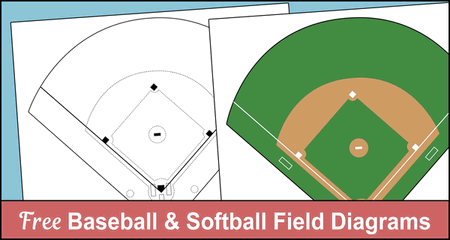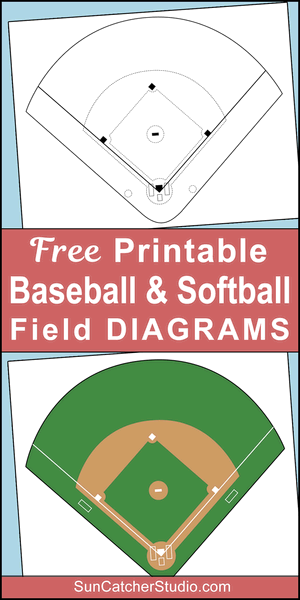Printable Baseball Field Diagram (Softball Diamond) Templates
Free printable baseball field diagrams and softball field templates for coaching, rule understanding, and game planning. Templates include infield, outfield, coaching boxes, batter boxes, foul lines, etc. For more ideas see printables and court and field diagrams.

Download your free printable baseball diamond diagram (softball field) template by selecting either “PDF format” or “PNG format”. You can also change the COLOR by selecting the “Save/Edit” button. See notes below.
Free Printable Baseball Field and Softball Diamond Diagrams
- 1. Baseball diamond (Softball field) diagram.
- ○ PDF format
- ○ PNG format
- 2. Baseball field diagram.
Labeled. - ○ PDF format
- ○ PNG format
- 3. Free printable baseball field diagram.
Colored. - ○ PDF format
- ○ PNG format
NOTE: By selecting the “Save/Edit” button you can customize or personalize your baseball or softball field diagram. You can add your own text or change colors to make the layout uniquely yours. After selecting new colors, specify the height as “3000 pixels” to ensure high resolution and to make sure your field diagram fits on the entire piece of paper.
A basic baseball field diagram or softball field layout includes the following helpful information for both the players and coaches:
- Infield:
- Pitcher’s Mound: A circular area in the center of the infield where the pitcher stands.
- Home Plate: The pentagonal-shaped plate where the batter stands.
- Bases (First, Second, and Third): Square bags placed at the corners of the diamond.
- Outfield – The outfield refers to the area of the playing field that is situated beyond the infield. It is where outfielders, defensive players, position themselves to catch or field the ball hit by the opposing team’s batters. The outfield is typically divided into three main positions: left field, center field, and right field.
- Dugouts – Typically the home team dugout is located along the first baseline. The visitor team dugout is typically located along the third baseline.
- Coaching Boxes – First and Third Base Coaching Boxes: Designated areas where the first and third base coaches stand to coach base runners.
- Batter’s Boxes – Right-Handed Batter’s Box: Adjacent to home plate on the third base side. Left-Handed Batter’s Box: Adjacent to home plate on the first base side.
- Foul Lines – First and Third Base Foul Lines: Extend from home plate to the outfield fence.
Uses for Court and Field Diagrams
Court and field diagrams provide a visual representation of the dimensions, markings, and layout of a particular sport. They serve the following important purposes:
- Clarity and Communication. Coaches, players, and referees can use field diagrams to communicate strategies, tactics, and game plans effectively. It provides a common reference point for discussions and instructions.
- Training. During training sessions, coaches can use field diagrams to explain drills, positional play, and set-piece strategies. This visual aid helps players better understand their roles and responsibilities on the field.
- Rule Understanding. For new players or those unfamiliar with the rules of particular sport, a field diagram can be a helpful tool for understanding the various markings, lines, and areas on the field that have specific rules associated with them.
- Officiating. Referees use field diagrams to ensure that the game is played within the proper dimensions and that players adhere to the rules related to markings, penalty areas, and other field elements.
- Game Planning. Teams use field diagrams to analyze opponents, plan strategies, and make tactical decisions. Understanding the layout of the field helps in determining where players should position themselves during different phases of the game.
- Fan Education. Field diagrams are also useful for educating fans about the game. They help fans understand key areas on the field, such as the penalty box or center circle, and enhance their overall enjoyment and comprehension of the sport.
- Uniformity. Having a standard field diagram ensures uniformity across different levels of play. This consistency helps maintain the integrity of the game and ensures that everyone involved understands the playing environment.
In summary, a field diagram is a practical tool that aids in communication, training, officiating, game planning, and overall understanding of the game’s dynamics and rules.
Pin for later!

Pattern Uses and Types of Materials
You can use these patterns, stencils, templates, models, and shapes as a guide to make other objects or to transfer designs. Create personalized, custom projects for your home, for craft shows, for selling projects online, etc. These designs are great for coloring pages and coloring sheets, crochet patterns, drawing and painting, svg files for cricut and silhouette, svg cut files, hobbies, holiday crafts, iron-on designs, kid crafts, laser cutting, needlecrafts, preschool printables, quilting, sewing, scrapbooking, sign making, string art (nail art), wall art, wedding crafts, woodworking projects, and other DIY arts and crafts.Looking for More Patterns, Stencils, Designs?
Discover Cricut Designs or create a Family Name Sign.



